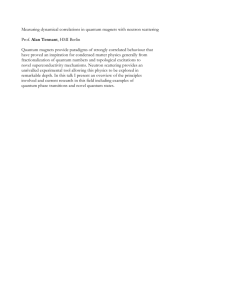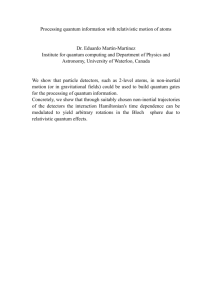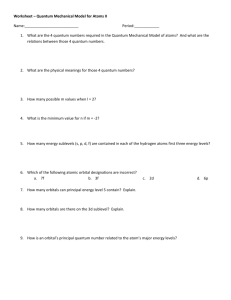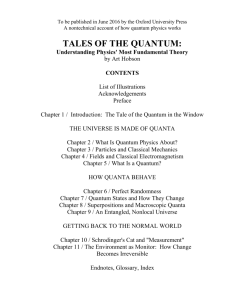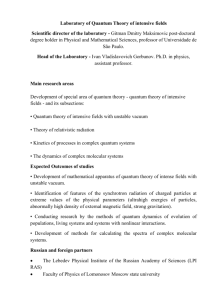Plenary Talks
advertisement
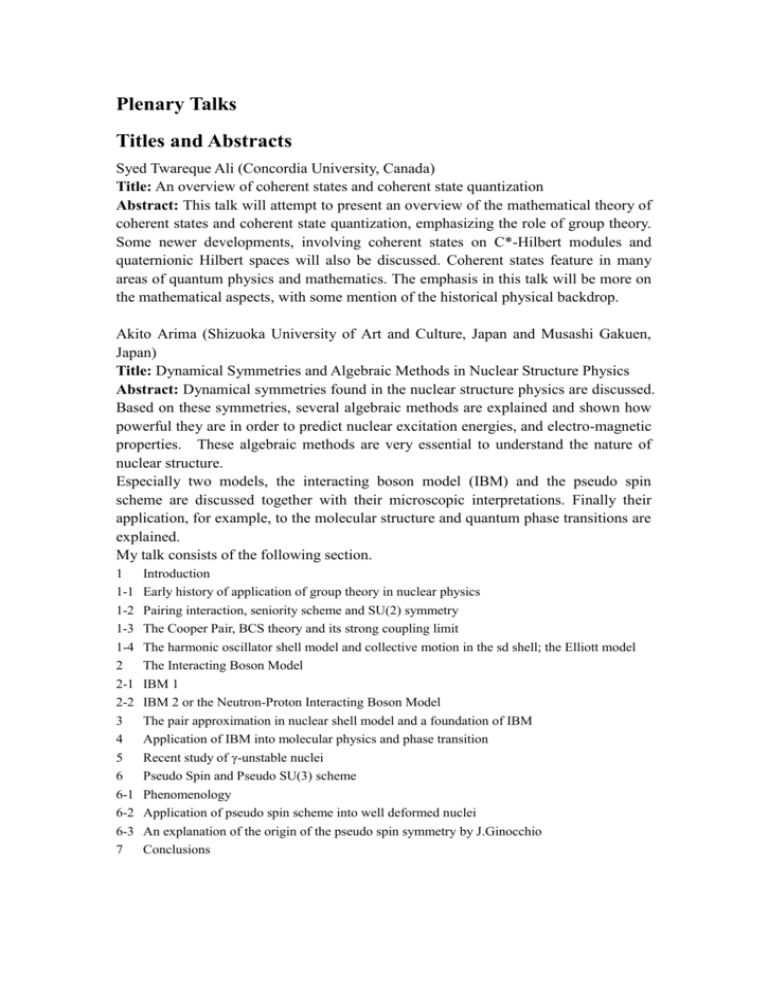
Plenary Talks Titles and Abstracts Syed Twareque Ali (Concordia University, Canada) Title: An overview of coherent states and coherent state quantization Abstract: This talk will attempt to present an overview of the mathematical theory of coherent states and coherent state quantization, emphasizing the role of group theory. Some newer developments, involving coherent states on C*-Hilbert modules and quaternionic Hilbert spaces will also be discussed. Coherent states feature in many areas of quantum physics and mathematics. The emphasis in this talk will be more on the mathematical aspects, with some mention of the historical physical backdrop. Akito Arima (Shizuoka University of Art and Culture, Japan and Musashi Gakuen, Japan) Title: Dynamical Symmetries and Algebraic Methods in Nuclear Structure Physics Abstract: Dynamical symmetries found in the nuclear structure physics are discussed. Based on these symmetries, several algebraic methods are explained and shown how powerful they are in order to predict nuclear excitation energies, and electro-magnetic properties. These algebraic methods are very essential to understand the nature of nuclear structure. Especially two models, the interacting boson model (IBM) and the pseudo spin scheme are discussed together with their microscopic interpretations. Finally their application, for example, to the molecular structure and quantum phase transitions are explained. My talk consists of the following section. 1 1-1 1-2 1-3 1-4 2 2-1 2-2 3 4 5 6 6-1 6-2 6-3 7 Introduction Early history of application of group theory in nuclear physics Pairing interaction, seniority scheme and SU(2) symmetry The Cooper Pair, BCS theory and its strong coupling limit The harmonic oscillator shell model and collective motion in the sd shell; the Elliott model The Interacting Boson Model IBM 1 IBM 2 or the Neutron-Proton Interacting Boson Model The pair approximation in nuclear shell model and a foundation of IBM Application of IBM into molecular physics and phase transition Recent study of γ-unstable nuclei Pseudo Spin and Pseudo SU(3) scheme Phenomenology Application of pseudo spin scheme into well deformed nuclei An explanation of the origin of the pseudo spin symmetry by J.Ginocchio Conclusions Murray Batchelor (Australian National University, Australia) Title: The surprising connection between discrete holomorphicity and integrability Abstract: This talk will be about exactly solved lattice models in statistical mechanics, a richly rewarding area of mathematical physics which continues to fascinate over many decades of activity. Over the past few years it has been discovered that an "observable" can be set up on the lattice which obeys the discrete Cauchy-Riemann equations. The ensuing condition of discrete holomorphicity leads to a system of linear equations which can be solved to yield the Boltzmann weights of the underlying lattice model. Surprisingly, these are the well known Boltzmann weights which satisfy the star-triangle or Yang-Baxter equations at criticality. This connection has been observed for a number of exactly solved models. In this talk I will review these developments and discuss how this connection can be made explicit in the context of the Z_N model. I will also discuss how discrete holomorphicity has been used in recent breakthroughs in the rigorous proof of key results in the theory of planar self-avoiding walks. Edward Corrigan (University of York, UK) Title: Aspects of defects in integrable quantum field theory Abstract: Surprisingly, some integrable classical and quantum field theories allow defects that do not destroy integrability. The main examples lie within affine Toda field theory of which the sine-Gordon and Tzitzeica models are the simplest. A suitable classical framework, together with infinite dimension representations of quantum algebras needed for the description of defects, will be described. Mo-Lin Ge (Nankai University, China) Title: Yang-Baxter System and Quantum Information Abstract: The braiding matrix related to the Bell basis can be Yang-Baxterized to including spectral parameter u. The resultant u-dependent Ř(u)-matrix is called type-II solution of YBE. In comparison with the familiar rational solution of YBE associated with spin chain models, called the type-I, both of them belong to T-L algebra. The loop value d is 2 for the type-I, whereas 2 for the type-II. Acting the T-L operators on the topological basis it leads to, say, 2-dimensimal solution of YBE: A(θ3)B(θ2,φ) A(θ1)= B(θ1,φ) A(θ2) B(θ3,φ) where A stands for the braiding between 1 and 2, whereas B for 2 and 3. The following results have been obtained: (1) There holds Galilio velocity additivity for the type-I as expected, but Lorentzian additivity for the type-II, i.e. two anyons may obey the Lorentz rule of velocity additivity, if YBE holds. (2) The existence of the two types may be due to the extremum of the L1-norm of the Wigner D-functions. (3) The type-II solution of YBE may be simulated with quantum optics. (4) The 3-dimonsional topological basis related to the Birman-Wenzl-Murakami algebra has been constructed. The physical application is discussed. This is a joint work with Kang Xue. Razvan Gurau (Perimeter Institute for Theoretical Physics, Canada) Title: The large N limit of Tensor Models Abstract: Matrix models are a highly successful framework for the analytic study of random two dimensional surfaces with applications to quantum gravity in two dimensions, string theory, conformal field theory, statistical physics in random geometry, etc. . The size of the matrix, N , endows a matrix model with a small parameter, 1/N , and its perturbative expansion can be reorganised as series in 1/N . The leading order contribution represents planar surfaces. As the leading order is summable, matrix models undergo a phase transition to a continuum theory of random, infinitely refined, surfaces. In higher dimensions matrix models generalise to tensor models. In the absence of a viable 1/N expansion tensor models have for a long time been less successful in providing an analytically controlled theory of random higher dimensional topological spaces. This situation has drastically changed recently. Models for a generic complex tensor have been shown to admit a 1/N expansion dominated by graphs of spherical topology in arbitrary dimensions and to undergo a phase transition to a continuum theory. I will present an overview of these results and discuss their implications to statistical mechanics, integrable systems, quantum field theory, random discrete geometries and probability theory. Jerzy Lewandowski (Uniwersytet Warszawski, Poland) Title: Loop Quantizable Gravity Abstract: For several models of gravity coupled to other fields, the algorithm of the canonical quantization has been completed and performed to an end. It gave rise to well defined, exact quantum theories. The Dirac observables are provided by the relational and the deparametrization frameworks. The quantum states, Hilbert spaces and concrete quantum operators are furnished by the canonical Loop Quantum Gravity framework. The models are not confirmed experimentally and admit ambiguities, but they are there, available for farther study and applications. Alden Mead (University of Minnesota, USA) Title: Permutation Symmetry for Molecular Systems with Identical Nuclei Abstract: The development of the study of degeneracy manifolds which contain symmetry manifolds as submanifolds in molecular systems of identical nuclei is reviewed, particularly with respect to the symmetry of electronic wave functions under permutations of identical nuclei. Early progress has been mainly in the systems X3 and X4, for which there are two simplifying features, viz: The number of internuclear distances is the same as the number of internal coordinates, and the deviations from degeneracy can often be described in terms of a two-dimensional irreducible representation of the relevant permutation group. We consider the study of systems of more than four identical nuclei, concentrating on the X5 system. We show that for such system there exists no internal coordinate system that treats all identical nuclei equivalently. The problem of constructing electronic wave functions which are single-valued with respect to the nuclear coordinates is discussed, both for the integer and half-odd integer electronic spin cases. Jun Murakami (Waseda University, Japan) Title: Quantum invariants of knots and the hyperbolic volume Abstract: Recently, several quantum invariants are constructed from the restricted quantum groups. I would like to review these constructions, to explain their relation to the hyperbolic volume, and to give some applications. Vincent Rivasseau (University Paris-Sud XI, France) Title: Tensor Field theories Abstract: We present an approach to emergent space-time and quantum gravity which is based on recent progress on the analysis of large random tensors, with particular emphasis on the construction of renormalizable tensor field theories. Daniel Treille (CERN and ETHZ, Switzerland) Title: Towards the origin? Abstract: The young expanding Universe, at its first moments, went through a series of transitions which shaped its present structure. Our understanding of these phases comes from direct observation of the Cosmos, using various messengers from the past. It also comes from experiments performed at colliders, allowing to re-create at small scale the physics which prevailed at a given time in the evolution of the Universe. Facts are reasonably well established until the first picosecond (10**-12 s). At shorter times one needs to extrapolate within various models, and hypotheses replace certainties, in particular concerning the short win of matter over antimatter. The present status of our understanding will be reviewed. Special attention will be given to results from the LHC collider including the recently announced discovery of a new particle, as well as to recent advances in neutrino physics. Zhenghan Wang (Microsoft Station Q, USA) Title: Building a Quantum Computer: A Microsoft Approach Abstract: Topological phases of matter can be used to build inherently fault-tolerant quantum computers. I will give an introduction to this approach as pursued in Microsoft Station Q, where quantum algebraic structures such as quantum groups or modular categories play an essential role.


